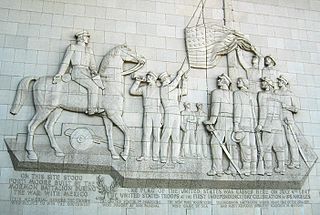Related Research Articles
The Mountain Meadows Massacre was a series of attacks which resulted in the mass murder of 120 members of the Baker–Fancher emigrant wagon train. The massacre occurred September 7–11, 1857 at Mountain Meadows in southern Utah, and was perpetrated by Mormon settlers belonging to the Utah Territorial Militia, together with some Southern Paiute Native Americans.
The Utah War (1857–1858), also known as the Utah Expedition, Utah Campaign, Buchanan's Blunder, the Mormon War, or the Mormon Rebellion was an armed confrontation between Mormon settlers in the Utah Territory and the armed forces of the US government. The confrontation lasted from May 1857 to July 1858. There were some casualties, most of which were non-Mormon civilians. The war had no notable military battles.

The Mormon Battalion was the only religious unit in United States military history in federal service and was recruited solely from one religious body and having a religious title as the unit designation. The volunteers served from July 1846 to July 1847 during the Mexican–American War of 1846–1848. The battalion was a volunteer unit of between 534 and 559 Latter-day Saint men, led by Mormon company officers commanded by regular U.S. Army officers. During its service, the battalion made a grueling march of nearly 2,100 miles from Council Bluffs, Iowa, to San Diego, California.

George Albert Smith was an early leader in the Latter Day Saint movement. He served in the Quorum of the Twelve Apostles and as a member of the First Presidency of The Church of Jesus Christ of Latter-day Saints.

Old Las Vegas Mormon Fort State Historic Park is a state park of Nevada, USA, containing the Old Mormon Fort, the first structure built by people of European heritage in what would become Las Vegas fifty years later. In present-day Las Vegas, the site is at the southeast corner of Las Vegas Boulevard and Washington Avenue, less than one mile north of the downtown area and Fremont Street. This is the only U.S. state park located in a city that houses the first building ever built in that city. The fort was listed on the National Register of Historic Places on February 1, 1972. The site is memorialized with a tablet erected by The Church of Jesus Christ of Latter-day Saints in 1997, along with Nevada Historical Marker #35, and two markers placed by the Daughters of Utah Pioneers.

The Joseph Smith Memorial Building, originally called the Hotel Utah, is named in honor of Joseph Smith, the founder of the Latter Day Saint movement. It is located on the corner of Main Street and South Temple in Salt Lake City. It is now a social center with three restaurants: The Roof Restaurant, The Garden Restaurant and The Nauvoo Cafe. It is also a venue for events complete with 13 banquet rooms, catering services, event coordinators and a full-service floral department – Flowers Squared. Several levels of the building also serve as administrative offices for The Church of Jesus Christ of Latter-day Saints departments such as FamilySearch. On January 3, 1978, it was added to the National Register of Historic Places as the Hotel Utah.

Jefferson Hunt was a U.S. western pioneer, soldier, and politician. He was a captain in the Mormon Battalion, brigadier general in the California State Militia, a California State Assemblyman, and a representative to the Utah Territorial Legislature.

San Bernardino, California, was named in 1810.

The San Bernardino County Sheriff-Coroner's Department (SBSD) serves San Bernardino County, California, which is geographically the largest county in the United States and is headquartered in San Bernardino city. SBSD provides law enforcement services to the unincorporated areas of the county and contract law enforcement services to 14 of the county's cities, including Rancho Cucamonga and Chino Hills, serving a total of 1,029,466 of the county's 2 million residents. The department also operates the county jail system, provides marshal services for the county superior courts, and has numerous other specialized divisions to serve the citizens of San Bernardino County.
Jack Powers, whose real name was John A. Power, was an Irish-born migrant taken to New York as a child, a New York volunteer soldier in the Mexican American War, serving in the garrison of Santa Barbara, California. During the California Gold Rush, he was a well-known professional gambler and a famed horseman, in the gold camps, San Francisco, Santa Barbara and Los Angeles. He had two brushes with the law. Once being tried as a member of The Hounds, in San Francisco in 1849, and once in a dispute over land ownership of a ranch in Santa Barbara County in 1853. In 1856, at Santa Barbara, Powers had protected a fugitive from the vigilantes of San Francisco and helped him to escape. After his role was revealed the following year, he had difficulties with the vigilantes at Los Angeles, who accused him of being the leader of a criminal gang there. Long known for his skills as a horseman, on May 2, 1858, his skills were demonstrated in a record-breaking 150-mile time over distance race. Soon after this race, he was accused by San Luis Obispo vigilantes of complicity in the 1857 murder of two men, and of being the head of the bandit gang that plagued the southern central coastal region of California, along the El Camino Real with robberies and murders in San Luis Obispo County and Santa Barbara County between 1853 and 1858. This gang was later named the Jack Powers Gang in 1883, by Jesse D. Mason in his History of Santa Barbara County California. Escaping the vigilantes, by fleeing to Sonora, Powers attempted to return to California in 1860, but was murdered and robbed by his vaqueros at Calabasas just inside Arizona Territory.

As of December 31, 2019, The Church of Jesus Christ of Latter-day Saints reported 756,507 members in 153 stakes, 1,229 congregations, 228 Family History Centers, 15 missions, and seven temples in California.

Benjamin Hayes, or Benjamin Ignatius Hayes, (1815–77) was an American pioneer who was the first judge of the district court that served Los Angeles, San Diego and San Bernardino counties in California. His seminal rulings are still cited in that state's courts.

Bethel Coopwood (1827–1907) was born in Alabama, and moved to Texas and was a soldier in the Mexican–American War and an officer in the Confederate Army in the American Civil War. He was a lawyer, judge, and later a historian.
Flores Daniel Gang, was an outlaw gang also known as "las Manillas", throughout Southern California during 1856-1857. Californio's Juan Flores and Pancho Daniel. Contemporary newspaper accounts of las Manillas all reported that the leader of las Manillas was originally Pancho Daniel, but that Juan Flores assumed the leadership role after Daniel was injured in the Barton ambush. According to the account of Harris Newmark, Flores had been sent to prison for horse-stealing and was just another member of the gang.
William W. Twist (182?-1861) was possibly a Canadian native, a volunteer soldier in the Mexican American War in California, Sheriff of Santa Barbara County and captain of California Militia in Los Angeles. He was killed in action as a captain of artillery in the Mexican Army.
Myron Norton (1822–1886). an attorney, was an officer in the 1st Regiment of New York Volunteers, fighting in the Mexican–American War, and remained in California afterward to become active in both San Francisco and Los Angeles legal circles and politics. He drafted California's first state constitution.
Ezra Drown was an attorney who escaped a shipwreck to become the district attorney of Los Angeles County, California in 1857–59 and 1861–63 and a member of the Los Angeles Common Council, the governing body of the city of Los Angeles, in 1859 and 1861.
Obed Macy (1801–1857) and his son, Oscar Macy. were pioneers in Los Angeles County, California, arriving there by wagon train shortly after California became a part of the United States following the Mexican–American War. Both were members of the Los Angeles Common Council, the governing body of that city, and Oscar was the county sheriff and served on the county Board of Supervisors. They operated one of Los Angeles's historic hotels. Obed was a physician and Oscar, among other things, was a newspaper publisher.
George N. Whitman was elected to the Los Angeles, California, Common Council, the legislative branch of that city's government, in a special election on September 3, 1857, serving until May 10, 1858. As a resident of San Bernardino County, he was a member of the California State Assembly from the 1st District in 1859–60.
Benjamin Franklin Mathews (1819–1888) was elected Sheriff of San Bernardino County, California on September 14, 1863 and served from October, 1863 to October, 1865. Mathews was born April 16, 1819 in Chattanooga, Hamilton County, Tennessee. He arrived in Salt Lake in 1847 with Mormons, from Mississippi. He moved on to California in 1850, where he kept a hotel between Sacramento and Auburn. Mathews came south to arrive in the Mormon colony of San Bernardino, on March 30, 1852. Here he was at various times a teamster, miller, Justice of the Peace and finally sheriff. Unlike many Mormons in San Bernardino he did not return to Utah during the Utah War in 1857.